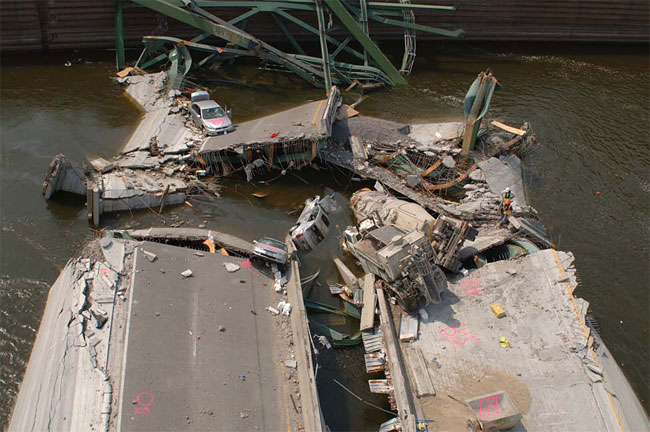 The Institution of Civil Engineers hosted a seminar on "learning from bridge failure" on 24th September. In the wake of the I-35W disaster (pictured) and Montreal overpass collapse, it was felt that perhaps more can be done in the UK to share the lessons of bridge failures, and try and minimise the chance of similar catastrophes occurring elsewhere. The recorded video of the seminar is available along with all the presentations at ICE's lectures website.
The Institution of Civil Engineers hosted a seminar on "learning from bridge failure" on 24th September. In the wake of the I-35W disaster (pictured) and Montreal overpass collapse, it was felt that perhaps more can be done in the UK to share the lessons of bridge failures, and try and minimise the chance of similar catastrophes occurring elsewhere. The recorded video of the seminar is available along with all the presentations at ICE's lectures website. Graham Tilly used a similar range of examples, including the 1967 Silver Bridge eyebar failure (pictured) and 2003 Kinzua Viaduct collapse to identify a recurring theme of inadequate inspections - many bridges which fail have been inspected recently beforehand, but the flaw that leads to collapse is not identified. Partly this is because inspectors concentrate on "serviceability" defects such as surface rust, cracking and spalling, rather than the key non-redundant components which can lead to ultimate collapse. It's also because many defects (as on Montreal's half-joints or Kinzua's anchor bolts) are hidden from normal view.
Graham Tilly used a similar range of examples, including the 1967 Silver Bridge eyebar failure (pictured) and 2003 Kinzua Viaduct collapse to identify a recurring theme of inadequate inspections - many bridges which fail have been inspected recently beforehand, but the flaw that leads to collapse is not identified. Partly this is because inspectors concentrate on "serviceability" defects such as surface rust, cracking and spalling, rather than the key non-redundant components which can lead to ultimate collapse. It's also because many defects (as on Montreal's half-joints or Kinzua's anchor bolts) are hidden from normal view.Other presentations covered the way in which bridges are overseen nationwide, including the roles of the UK Bridges Board, Bridge Owners Forum and County Surveyors' Society Bridges Group. Richard Fish's view was that with most major bridge owners represented on one or more of these bodies, lessons from failure can be widely disseminated. I'm not so sure about that: there are several bridge owners who never engage with these bodies: privately operated transport networks like many tram schemes; docks and industrial facilities like refineries; and building owners with car park bridges and link footbridges.
The role of SCOSS and its confidential reporting scheme CROSS were addressed, but as a voluntary agency SCOSS has no powers to investigate bridge failures, and its findings are not always widely disseminated. They have issued a briefing note on the Montreal collapse and also plan to report on the recent GE19 bridge slip (already extensively reported by Transport for London). This highlights the difference a proactive and engaged client body can make; generally less disturbed by the prospects of legal action than are consultants and contractors, they may be better placed to obtain and share relevant lessons with others. I think many incidents are better reported independently however, particularly where failures of client management processes need to be highlighted. The Rail Accident Investigation Branch offers a good example of what can be achieved when there is legislative support (they will be issuing their own report on GE19 and it may be interesting to compare it with TfL's).
One of the most provocative presentations came from Jolyon Gill, who noted the paradox that if there are fewer bridge failures, we will learn less and be less able to prevent them in future. This perhaps accords with the idea (presented by Henry Petroski and others) that major bridge failures go in 30-year cycles (roughly corresponding to the time it takes a new generation of bridge engineers to forget the lessons the previous generation had learnt!), with examples including the 3-decade lapse between the Merrison box girder failures, and the (fortunately non-fatal) failure of the Millennium Bridge to perform as desired.
Gill also quoted Alfred Pugsley's phrase that there is an "engineering climatology of structural accidents", where failures relate not only to engineering ignorance and negligence, but also to political, financial and other professional pressures. In this respect, it's unclear whether the prevailing tendency of UK bridge clients to procure on lowest cost may lead to an increased likelihood of error and hence failure (certainly the quality of bridge maintenance inspections procured by local authorities is often less than satisfactory). Personally, I think cost pressures may instead lead to an absolute avoidance of risk in design, with the consequent discouragement of the innovative structures which are most likely to fail.
The lesson of many past bridge failures is that increased risk of failure is an inevitable corollary of innovation. However, the I-35W and Montreal incidents highlight the fact that we are now in an era where bridge engineers spend more time maintaining existing infrastructure than building new structures. This is a world where the evidence is that inspections are not always thorough, proper maintenance is often postponed, and there is insufficient political understanding of the possible consequences to enable work to be well-funded. From the ICE seminar it's clear that bridge engineers understand the lessons of recent bridge collapses. The next question is whether our financial and political mastesr will do likewise.
No comments:
Post a Comment